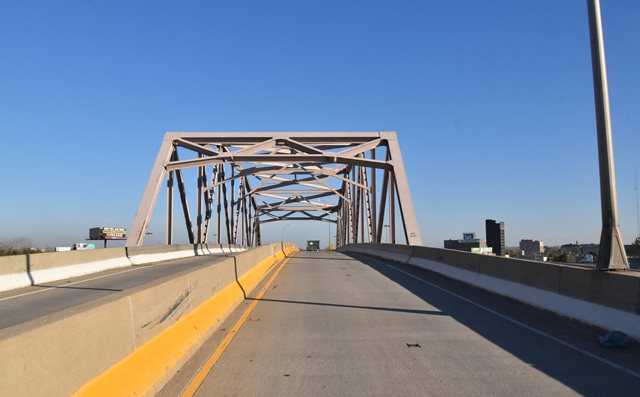We Recommend:
Bach Steel - Experts at historic truss bridge restoration.
BridgeHunter.com Phase 1 is released to the public! - Visit Now
Martin Luther King Bridge
Veterans Memorial Bridge

Primary Photographer(s): Nathan Holth and Rick McOmber
Bridge Documented: November 15, 2016 and August 27, 2021
MO-799 S (Historic US-66) Over Mississippi River and Various Streets and Railroads
St. Louis and East St. Louis: St. Louis City, Missouri and St. Clair County, Illinois: United States
Metal Cantilever 24 Panel Rivet-Connected Warren Through Truss, Fixed and Approach Spans: Metal 8 Panel Rivet-Connected Warren Deck Truss, Fixed
1951 By Builder/Contractor: J. Howard, Inc. of Chicago, Illinois and Engineer/Design: Hazelet and Erdal of Chicago, Illinois, George A. Maney, and Charles Alton Ellis
1988
962.0 Feet (293.2 Meters)
4,010.0 Feet (1222.2 Meters)
38 Feet (11.58 Meters)
3 Main Span(s) and 31 Approach Span(s)
82600100000000

View Information About HSR Ratings
Bridge Documentation
View Archived National Bridge Inventory Report - Has Additional Details and Evaluation
View Historical Newspaper Article For Grand Opening of This Bridge
Although this is a relatively late example of a riveted cantilever through truss, it remains highly significant due to the increasing rarity of this bridge type in the United States thanks to demolition. Further, the bridge is technologically significant for the length of the main cantilever span.
Planning for the bridge was directed by the engineering firm of George A. Maney and Associates. George A. Maney died during the early engineering stages of the project. Maney, according to local news articles, was also working with Charles A. Ellis on this project, but he died in 1949, so apparently his involvement with this bridge was only in the design stage. Ellis is of note in engineering history as he was responsible for the majority of the engineering design of the Golden Gate Bridge. After these deaths, engineering was taken over by another noted engineering firm, Hazelet and Erdal.
Many contractors were involved with the actual bridge construction. The general contractor for the bridge was J. Howard, Inc. of Chicago, Illinois. Massman Construction Company of Kansas City, Missouri (successor to the noted Kansas City Bridge Company of Kansas City, Missouri) was the substructure contractor. A number of contractors and subcontractors were involved with the superstructure fabrication and erection. These included the Robinson Erection Company of St. Louis, Missouri, Midland Steel and Allied Fabricators, Stupp Brothers of St. Louis, Missouri, and the Bethlehem Steel Company of Bethlehem, Pennsylvania, and John F. Beasley Company of Muskogee, Oklahoma.
The configuration of the bridge is as follows:
Missouri Approach
- Span W: 45'-0" simple beam span
- Spans X, Y, 1 and
2: 238'-0" continuous four-span beam span
- Span 3: 53'-0" simple beam span
- Spans 4 and 6: 240'-0" continuous two-span girder/stringer/cross-beam span (no
existing span is identified as Span 5)
- Spans 7 - 8: 94'-0" continuous
two-span beam span Main Spans
- Spans 9 - 11: 1902'-10" three-span
cantilevered through truss
Illinois Approach
- Spans 12 and 13: 213'-1"
simple deck truss spans
- Spans 14 - 17, 19 - 22, 24 - 27 and 29 - 32:
216'-3" continuous four-span beam spans
- Spans 18, 23 and 28: 45'-9" simple
beam spans
Structurally a separate bridge (dimensions omitted from technical facts table above), but otherwise part of the same bridge system is the Illinois Approach Bridge, immediately east of this bridge. The main span of this bridge is a rivet-connected polygonal Warren through truss.

Above: Panoramic view of cantilever truss spans.

Above: The Illinois Approach Bridge.
This bridge is tagged with the following special condition(s): Unorganized Photos
![]()
Photo Galleries and Videos: Martin Luther King Bridge
Bridge Photo-Documentation
Original / Full Size PhotosA collection of overview and detail photos. This gallery offers photos in the highest available resolution and file size in a touch-friendly popup viewer.
Alternatively, Browse Without Using Viewer
![]()
Bridge Photo-Documentation
Mobile Optimized PhotosA collection of overview and detail photos. This gallery features data-friendly, fast-loading photos in a touch-friendly popup viewer.
Alternatively, Browse Without Using Viewer
![]()
Additional Unorganized Photos
Original / Full Size PhotosA supplemental collection of photos that are from additional visit(s) to the bridge and have not been organized or captioned. This gallery offers photos in the highest available resolution and file size in a touch-friendly popup viewer.
Alternatively, Browse Without Using Viewer
![]()
Additional Unorganized Photos
Mobile Optimized PhotosA supplemental collection of photos that are from additional visit(s) to the bridge and have not been organized or captioned. This gallery features data-friendly, fast-loading photos in a touch-friendly popup viewer.
Alternatively, Browse Without Using Viewer
![]()
Maps and Links: Martin Luther King Bridge
Coordinates (Latitude, Longitude):
Search For Additional Bridge Listings:
Bridgehunter.com: View listed bridges within 0.5 miles (0.8 kilometers) of this bridge.
Bridgehunter.com: View listed bridges within 10 miles (16 kilometers) of this bridge.
Additional Maps:
Google Streetview (If Available)
GeoHack (Additional Links and Coordinates)
Apple Maps (Via DuckDuckGo Search)
Apple Maps (Apple devices only)
Android: Open Location In Your Map or GPS App
Flickr Gallery (Find Nearby Photos)
Wikimedia Commons (Find Nearby Photos)
Directions Via Sygic For Android
Directions Via Sygic For iOS and Android Dolphin Browser
USGS National Map (United States Only)
Historical USGS Topo Maps (United States Only)
Historic Aerials (United States Only)
CalTopo Maps (United States Only)



